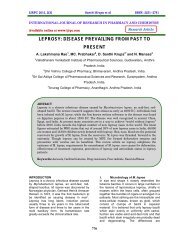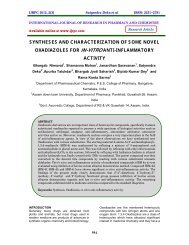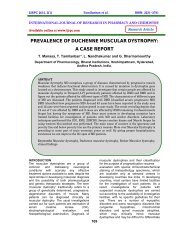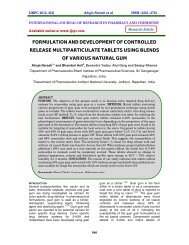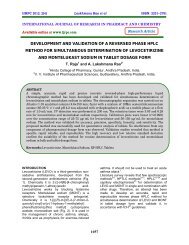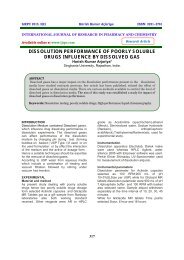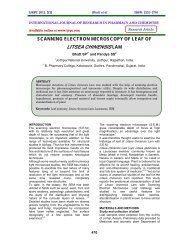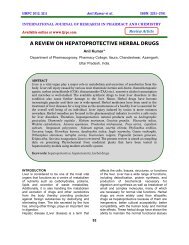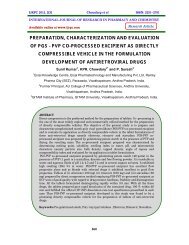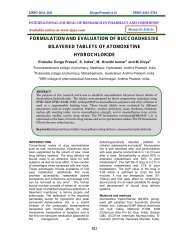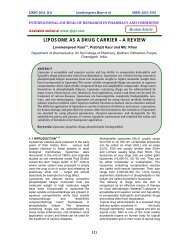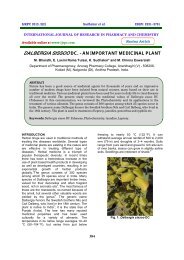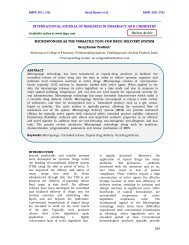evaluation of anti-diabetic activity of leaves of cassia ... - ijrpc
evaluation of anti-diabetic activity of leaves of cassia ... - ijrpc
evaluation of anti-diabetic activity of leaves of cassia ... - ijrpc
Create successful ePaper yourself
Turn your PDF publications into a flip-book with our unique Google optimized e-Paper software.
IJRPC 2011, 1(4) Prabh Simran Singh et al. ISSN: 22312781<br />
INTERNATIONAL JOURNAL OF RESEARCH IN PHARMACY AND CHEMISTRY<br />
Available online at www.<strong>ijrpc</strong>.com<br />
Research Article<br />
EVALUATION OF ANTI-DIABETIC ACTIVITY OF<br />
LEAVES OF CASSIA OCCIDENTALIS<br />
Prabh Simran Singh 1 *, Chetan Salwan 2 and A.S. Mann 3<br />
1 SBS College <strong>of</strong> Pharmacy, Patti, Tarn-Taran Punjab, India.<br />
2 S. Sukhjinder Singh College <strong>of</strong> Pharmacy, Gurdaspur, Punjab.<br />
3B.I.S College <strong>of</strong> Pharmacy, Moga, Punjab, India.<br />
*Corresponding Author: prabh.7750@gmail.com<br />
ABSTRACT<br />
Many plants synthesize substances that are useful to the maintenance <strong>of</strong> health in humans<br />
and other animals. These include aromatic substances, most <strong>of</strong> which are phenols or their<br />
oxygen-substituted derivatives such as tannins. Many are secondary metabolites, <strong>of</strong> which<br />
at least 12,000 have been isolated — a number estimated to be less than 10% <strong>of</strong> the total. In<br />
many cases, substances such as alkaloids serve as plant defense mechanisms against<br />
predation. Diabetes mellitus <strong>of</strong>ten simply referred to as diabetes—is a condition in which a<br />
person has a high blood sugar (glucose) level as a result <strong>of</strong> the body either not producing<br />
enough insulin, or because body cells do not properly respond to the insulin that is<br />
produced. Insulin is a hormone produced in the pancreas which enables body cells to<br />
absorb glucose, to turn into energy. Cassia occidentalis is an annual shrub. The <strong>leaves</strong>, roots<br />
& entire plant as such has been used in various countries like China, Brazil, Sri Lanka &<br />
India in the treatment <strong>of</strong> the variety <strong>of</strong> ailments such as malaria, liver diseases, fungal<br />
infections etc.Thorough literature survey for the chemical nature <strong>of</strong> the plant reveals that<br />
the plant contains quinines, flavonoids, saponins and alkaloids. The ethnomedical<br />
information reveals the plant has been used to treat diabetes.<br />
Keywords: Insulin, Diabetes, Hyperglycemia, Pancreas, Hormone.<br />
INTRODUCTION<br />
Many <strong>of</strong> the herbs and spices used by humans<br />
to season food yield useful medicinal<br />
compounds (Lai & Roy, 2004). The use <strong>of</strong><br />
herbal medicines in the right way provides<br />
effective and safe treatment for many<br />
ailments. The effectiveness <strong>of</strong> the herbal<br />
medicines is mostly subjective to the patient.<br />
The potency <strong>of</strong> the herbal medicines varies<br />
based on the genetic variation <strong>of</strong> the herbs,<br />
growing conditions <strong>of</strong> the herbs, timing and<br />
method <strong>of</strong> harvesting <strong>of</strong> the herbs, exposure <strong>of</strong><br />
the herbs to air, light and moisture, and type<br />
<strong>of</strong> preservation <strong>of</strong> the herbs. Herbal medicines<br />
can be used for healing purposes and to<br />
promote wellness. Herbal medicines are not<br />
addictive or habit forming, but are powerful<br />
nutritional agents that support the body<br />
naturally. Herbal medicines promote health<br />
and serve as excellent healing agents without<br />
side effects. Chinese herbs are taken as tonics<br />
to enhance physical and mental well-being.<br />
Herbal medicines are safe and effective for<br />
health, healing, weight loss/ gain/<br />
maintenance, etc. Herbal medicine can nourish<br />
the body’s deepest and most basic elements.<br />
Herbal medicines are great body balancers<br />
that help regulate body functions. Natural<br />
therapies such as herbal medicines can be used<br />
to support balance process <strong>of</strong> our body.<br />
Herbal medicines <strong>of</strong>fer the nutrients that the<br />
904
IJRPC 2011, 1(4) Prabh Simran Singh et al. ISSN: 22312781<br />
body fails to receive due to poor diet or<br />
environmental deficiencies in the soil and air.<br />
If the body cells do not absorb the glucose, the<br />
glucose accumulates in the blood<br />
(hyperglycemia), leading to various potential<br />
medical complications (Rother, 2007).<br />
There are many types <strong>of</strong> diabetes, the most<br />
common <strong>of</strong> which are<br />
Type 1 diabetes<br />
Results from the body's failure to produce<br />
insulin, and presently requires the person to<br />
inject insulin.<br />
Type 2 diabetes<br />
Results from insulin resistance, a condition in<br />
which cells fail to use insulin properly,<br />
sometimes combined with an absolute insulin<br />
deficiency.<br />
Gestational diabetes is when pregnant<br />
women, who have never had diabetes before,<br />
have a high blood glucose level during<br />
pregnancy. It may precede development <strong>of</strong><br />
type 2 DM. As <strong>of</strong> 2009 at least 271 million<br />
people worldwide suffer from diabetes, or<br />
2.8% <strong>of</strong> the population.Type 2 diabetes is by<br />
far the most common, affecting 80 to 85% <strong>of</strong><br />
the total diabetes population.<br />
Classification<br />
Most cases <strong>of</strong> diabetes mellitus fall into the<br />
three broad categories<br />
<strong>of</strong> type 1 or type 2 and gestational diabetes. A<br />
few other types are described:<br />
The term diabetes, without qualification,<br />
usually refers to diabetes mellitus, which<br />
roughly translates to excessive sweet urine<br />
(known as "glycosuria"). Several rare<br />
conditions are also named diabetes. The most<br />
common <strong>of</strong> these is diabetes insipidus in<br />
which large amounts <strong>of</strong> urine are produced<br />
(polyuria), which is not sweet (insipidus<br />
meaning "without taste" in Latin). The term<br />
"type 1 diabetes" has replaced several former<br />
terms, including childhood-onset diabetes,<br />
juvenile diabetes, and insulin-dependent<br />
diabetes mellitus (IDDM). Likewise, the term<br />
"type 2 diabetes" has replaced several former<br />
terms, including adult-onset diabetes, obesityrelated<br />
diabetes, and non-insulin-dependent<br />
diabetes mellitus (NIDDM). Beyond these two<br />
types, there is no agreed-upon standard<br />
nomenclature. Various sources have defined<br />
"type 3 diabetes" as: gestational<br />
diabetes, insulin-resistant type 1 diabetes (or<br />
"double diabetes"), type 2 diabetes which has<br />
progressed to require injected insulin,<br />
and latent autoimmune diabetes <strong>of</strong> adults (or<br />
LADA or "type 1.5" diabetes).<br />
Overview <strong>of</strong> the most significant symptoms<br />
<strong>of</strong> diabetes<br />
The classical symptoms <strong>of</strong> DM arepolyuria<br />
(frequent urination), polydipsia (increased<br />
thirst) andpolyphagia (increased hunger)<br />
(Cooke &Plotnick,2008). Symptomsmay<br />
develop quite rapidly (weeks or months) in<br />
type 1 diabetes, particularly in children.<br />
However, in type 2 diabetes symptoms<br />
usually develop much more slowly and may<br />
be subtle or completely absent. Type 1<br />
diabetes may also cause a rapid yet significant<br />
weight loss (despite normal or even increased<br />
eating) and irreducible mental fatigue. All <strong>of</strong><br />
these symptoms except weight loss can also<br />
manifest in type 2 diabetes in patients whose<br />
diabetes is poorly controlled, although<br />
unexplained weight loss may be experienced<br />
at the onset <strong>of</strong> the disease. Final diagnosis is<br />
made by measuring the blood glucose<br />
concentration. When the glucose concentration<br />
in the blood is raised beyond its renal<br />
threshold (about 10 mmol/L, although this<br />
may be altered in certain conditions, such as<br />
pregnancy), reabsorption <strong>of</strong> glucose in<br />
the proximal renal tubuli is incomplete, and<br />
part <strong>of</strong> the glucose remains in<br />
the urine (glycosuria). This increases<br />
the osmotic pressure <strong>of</strong> the urine and inhibits<br />
reabsorption <strong>of</strong> water by the kidney, resulting<br />
in increased urine production (polyuria) and<br />
increased fluid loss. Lost blood volume will be<br />
replaced osmotically from water held in body<br />
cells and other body compartments, causing<br />
dehydration and increased thirst. A rarer but<br />
equally severe possibility is hyperosmolar<br />
nonketotic state, which is more common in<br />
type 2 diabetes and is mainly the result <strong>of</strong><br />
dehydration due to loss <strong>of</strong> body water. Often,<br />
the patient has been drinking extreme<br />
amounts <strong>of</strong> sugar-containing drinks, leading<br />
to a vicious circle in regard to the water loss. A<br />
number <strong>of</strong> skin rashes can occur in diabetes<br />
that is collectively known as <strong>diabetic</strong><br />
dermadromes.<br />
Causes<br />
Type 2 diabetes is determined primarily by<br />
lifestyle factors and genes (Riseruset al,2009).<br />
905
IJRPC 2011, 1(4) Prabh Simran Singh et al. ISSN: 22312781<br />
Lifestyle<br />
A number <strong>of</strong> lifestyle factors are known to be<br />
important to the development <strong>of</strong> type 2<br />
diabetes. In one study, those who had high<br />
levels <strong>of</strong> physical <strong>activity</strong>, a healthy diet, did<br />
not smoke, and consumed alcohol in<br />
moderation had an 82% lower rate <strong>of</strong> diabetes.<br />
When a normal weight was included the rate<br />
was 89% lower. In this study a healthy diet<br />
was defined as one high in fiber, with a high<br />
polyunsaturated to saturated fat ratio, and a<br />
lower mean glycemic index (Mozaffarianet al,<br />
2009) Obesity has been found to contribute to<br />
approximately 55% type 2 diabetes, and<br />
decreasing consumption <strong>of</strong> saturated<br />
fats and trans fatty acids while replacing them<br />
with unsaturated fats may decrease the<br />
risk. The increased rate <strong>of</strong> childhood obesity in<br />
between the 1960s and 2000s is believed to<br />
have lead to the increase in type 2 diabetes in<br />
children and adolescents ( Roselbloom&<br />
Silverstein, 2003). Environmental toxins may<br />
contribute to recent increases in the rate <strong>of</strong><br />
type 2 diabetes. A positive correlation has<br />
been found between the concentration in the<br />
urine <strong>of</strong> bisphenol A, a constituent <strong>of</strong> some<br />
plastics, and the incidence <strong>of</strong> type 2 diabetes<br />
(Lang et al,2008).<br />
Medical conditions<br />
Subclinical Cushing's syndrome (cortisol<br />
excess) may be associated with DM type 2<br />
(Iwasaki et al, 2008). The percentage <strong>of</strong><br />
subclinical Cushing's syndrome in the <strong>diabetic</strong><br />
population is about 9%. Diabetic patients with<br />
a pituitary microadenoma can improve<br />
insulin sensitivity by removal <strong>of</strong> these<br />
microadenomas(Taniguchi et al,<br />
2008).Hypogonadismis <strong>of</strong>ten associated with<br />
cortisol excessandtestosteronedeficiencyis also<br />
associated with diabetes mellitus type<br />
2(Saad&Gooren, 2009) even if the exact<br />
mechanism by which testosterone improve<br />
insulin sensitivity is still not known.<br />
Pathophysiology<br />
The pathophysiology <strong>of</strong> type 2 diabetes<br />
mellitus is characterized by peripheral insulin<br />
resistance, impaired regulation <strong>of</strong><br />
hepatic glucose production, and declining ß-<br />
cell function, eventually leading to ß-cell<br />
failure. The primary events are believed to be<br />
an initial deficit in insulin secretion and, in<br />
many patients, relative insulin deficiency in<br />
association with peripheral insulin resistance<br />
(Reaven,1998).<br />
Herbal <strong>anti</strong>-<strong>diabetic</strong> drugs<br />
It has become increasingly evident in recent<br />
years that a full spectrum <strong>of</strong> therapeutic<br />
agents for prevention & treatment <strong>of</strong> diabetes<br />
is far from being complete.In an attempt to fill<br />
this gap,drug development focus has now<br />
shifted to traditional herbal drugs for new &<br />
more effective drug therapies.The search for<br />
indigenous <strong>anti</strong>-<strong>diabetic</strong> plants is still going<br />
on.Several plants have been identified as<br />
potential source <strong>of</strong> drugs in Indian system <strong>of</strong><br />
ayurvedic medicine for treatment <strong>of</strong><br />
diabetes.Extracts <strong>of</strong> various plants have been<br />
shown to posseshypoglycaemic properties in<br />
experimental <strong>diabetic</strong> as well as normal<br />
animals<br />
MATERIAL AND METHOD<br />
Introduction <strong>of</strong> Diabetes in Mice<br />
Diabetes was induced in animals by a single<br />
intraperitoneal injection <strong>of</strong> alloxan (40 mg/kg)<br />
dissolved in 0.1 M citrate buffer (pH 4.5) after<br />
fasting for 24 hour. Blood samples for glucose,<br />
cholesterol and other estimations were<br />
obtained retro-orbitally from the inner canthus<br />
<strong>of</strong> eyes using microcapillaries. Rats with<br />
fasting blood glucose <strong>of</strong> more than 220 mg/dl<br />
were considered to be <strong>diabetic</strong> and were<br />
included in the present study.<br />
ALLOXAN<br />
The cellular site <strong>of</strong> action <strong>of</strong> alloxan and exact<br />
mechanisms involved in its toxicity are not<br />
completely understood. Number <strong>of</strong> studies<br />
have shown that alloxan disrupts the integrity<br />
<strong>of</strong> the β-cell plasma membrane .The site at<br />
which alloxan interacts with the cell<br />
membrane is uncertain. Some evidence<br />
indicates that alloxan actsat the site for sugar<br />
transport into the cell. On the other hand,<br />
there is also evidence to suggest that alloxan<br />
acts at a glucoreceptor site responsible for<br />
insulin release, which is separate from the<br />
transport site .It has also been proposed those<br />
alloxan , leads to mitochondrial dysfunction<br />
and interferes with intracellular glucose<br />
oxidation . There is a large variability in<br />
dosage <strong>of</strong> alloxan required to produce longstanding<br />
diabetes in different species, which is<br />
also compatible with life. In many<br />
experiments, a single dose (32 to 200 mg/kg)<br />
was adequate to produce desired degree <strong>of</strong><br />
hyperglycemia, while in certain other studies<br />
906
IJRPC 2011, 1(4) Prabh Simran Singh et al. ISSN: 22312781<br />
it had to be repeated after 3 days. In the<br />
chronic state, hyperglycemia remains constant<br />
and blood glucose levels <strong>of</strong> 400 mg or more<br />
can be expected after standard diabetogenic<br />
doses <strong>of</strong> alloxan and streptozotocin (STZ) ,<br />
high dosages <strong>of</strong> the β-cell toxin streptozotocin<br />
and alloxan induce severe insulin deficiency<br />
and IDDM with ketosis. Lower dosages<br />
calculated to cause a partial reduction <strong>of</strong> β-cell<br />
mass could be used to produce a mildly<br />
insulin-deficient state <strong>of</strong> NIDDM, without a<br />
tendency to ketosis .The dosage is difficult to<br />
judge to create stable NIDDM without either<br />
gradual recovery or deterioration into IDDM.<br />
Streptozotocin is preferred because it has more<br />
specific cytotoxicity, to β-cell <strong>of</strong> the pancreas.<br />
Qu<strong>anti</strong>tative Estimation <strong>of</strong> Blood Glucose<br />
Blood glucose level was estimated<br />
colorimetrically at 505 nm by Glucose<br />
Oxidase-Peroxidase (GOD-POD) method<br />
(Trinder's method) using a commercially<br />
available kit (Transasia Bio Medicals Ltd.<br />
Daman).<br />
Principle<br />
Qu<strong>anti</strong>tative estimation <strong>of</strong> blood glucose level<br />
by GOD-POD method is based on the<br />
principle that enzyme glucose oxidase reacts<br />
with glucose in the presence <strong>of</strong> oxygen and<br />
water to form gluconic acid and hydrogen<br />
peroxide. This hydrogen peroxide reacts with<br />
4-amino <strong>anti</strong>pyrine and 4-hydroxybenzoic<br />
acid in the presence <strong>of</strong> the enzyme peroxidase<br />
to form quinoneimine dye and water. The<br />
pink coloured end product has absorption<br />
maxima at 505 nm. The intensity <strong>of</strong> the pink<br />
colour formed is proportional to the glucose<br />
concentration.<br />
Glucose +O 2 + H 2OGlucose oxidase Gluconic acid + H 2O 2<br />
H 2O 2 + 4HBA + 4AAPPeroxidaseQuinoneimine Dye + 2H 2O<br />
4AAP _______ 4-Amino<strong>anti</strong>pyrine<br />
4HBA _____ 4-Hydroxy benzoic acid.<br />
Serum separation<br />
Blood was withdrawn retro-orbitally with the<br />
help <strong>of</strong> microcapillaries. The collected blood<br />
was kept for 30 mins at room temperature.<br />
Serum from blood after clotting was separated<br />
out by centrifugation at 3000 rpm for 15<br />
minutes. The serum thus obtained was used<br />
for glucose and cholesterol estimations.<br />
Blank<br />
To 10 l <strong>of</strong> distilled water, 1000 l <strong>of</strong> glucose<br />
working reagent was added and the contents<br />
were thoroughly mixed.<br />
O.D. Test<br />
Concentration <strong>of</strong> glucose (mg/dl) = x 100<br />
O.D. Standard<br />
Standard<br />
To 10 µl <strong>of</strong> glucose standard (100 mg/dl), 1000<br />
l <strong>of</strong> glucose working reagent was added and<br />
the contents were thoroughly mixed.<br />
Test<br />
To 10 µl <strong>of</strong> serum, 1000 µl <strong>of</strong> glucose working<br />
reagent was added and were mixed<br />
thoroughly. The above solution was mixed<br />
well and incubated for 15 minutes at 37 0 C.<br />
The absorbance <strong>of</strong> standard and each test tube<br />
was read against blank at 505 nm.<br />
Qu<strong>anti</strong>tative Estimation <strong>of</strong> Serum Cholesterol<br />
Serum cholesterol was estimated at 505 nm by<br />
CHOD-PAP method (Modified Roeschlau's<br />
method) using a commercially available kit<br />
(Transasia Bio Medicals Ltd. Daman).<br />
Principle<br />
Qu<strong>anti</strong>tative estimation <strong>of</strong> serum cholesterol<br />
level by CHOD-PAP method is based upon<br />
the principle that enzyme cholesterol esterase<br />
reacts with cholesterol ester to form<br />
cholesterol and fatty acid. The cholesterol<br />
formed reacts with enzyme cholesterol oxidase<br />
in the presence <strong>of</strong> oxygen give rise to cholest-<br />
4-en-3-one and hydrogen peroxide. This<br />
hydrogen peroxide reacts with 4-<br />
amino<strong>anti</strong>pyrine and phenol in the presence <strong>of</strong><br />
quinoneimine dye and water. The pink<br />
colored end product has absorbance maxima<br />
at 505 nm. The intensity <strong>of</strong> pink color formed<br />
is proportional to the cholesterol<br />
concentration. 907
IJRPC 2011, 1(4) Prabh Simran Singh et al. ISSN: 22312781<br />
Cholesterol ester CE Gluconic acid + H2O2<br />
Cholesterol+O2 CHOD cholest-4-en-3-one + H2O2<br />
3H2O2 + 4AAP + Phenol POD Quinoneimine Dye + 2H2O<br />
CE_______Cholesterol esterase<br />
CHOD_______Cholesterol oxidase<br />
4AAP _______ 4-Amino<strong>anti</strong>pyrine<br />
POD _____ Peroxidase<br />
Blank<br />
To 20 l <strong>of</strong> distilled water, 1000 l <strong>of</strong><br />
cholesterol working reagent was added and<br />
the contents were thoroughly mixed.<br />
Standard<br />
To 20 µl <strong>of</strong> cholesterol standard (5.14mmol/l),<br />
1000 l <strong>of</strong> cholesterol working reagent was<br />
added and the contents were thoroughly<br />
mixed.<br />
Test<br />
To 20 µl <strong>of</strong> serum, 1000 µl <strong>of</strong> cholesterol<br />
working reagent was added and were mixed<br />
thoroughly. The above solution was mixed<br />
well and incubated for 15 minutes at 37 0 C.<br />
The absorbance <strong>of</strong> standard and each test tube<br />
was read against blank at 505 nm.<br />
Concentration <strong>of</strong> cholesterol (mmol/l) =<br />
O.D. Test<br />
O.D. Standard<br />
x 5.14mmol/l<br />
Serum Lipids<br />
Total cholesterol, LDL- and HDL- cholesterol<br />
and triacylglycerol were estimated using kits<br />
from Dr. Reddy's Pathology Lab-Hyderabad<br />
following manufacturer's instructions.<br />
HDL-CHOLESTEROL<br />
Principle: Low-density lipoproteins (LDL and<br />
VLDL) and chylomicron fraction was<br />
precipitated qu<strong>anti</strong>tatively by addition <strong>of</strong><br />
phosphotungstic acid in the presence <strong>of</strong><br />
magnesium ions. After centrifugation. The<br />
cholesterol concentration in HDL fraction,<br />
which remains in the supernatant, is<br />
estimated.<br />
LDL- Cholesterol<br />
After estimating total cholesterol, HDL<br />
cholesterol and triacylglycerol,<br />
Triacylglycerols The LDL cholesterol<br />
(mg/100ml)=Total Cholesterol+ HDL<br />
(Cholesterol ) /5(Friedelwald 1972).<br />
Estimation <strong>of</strong> the concentration <strong>of</strong> low –<br />
density lipoprotein cholesterol in plasma,<br />
without use <strong>of</strong> the preparative ultracentrifuge.<br />
Determination <strong>of</strong> Body Weight<br />
The body weight <strong>of</strong> the experimental animals<br />
was determined using a commercially<br />
available weighing balance, prior to alloxan<br />
treatment and after the administration <strong>of</strong><br />
alloxan.<br />
Experimental Protocol<br />
Four groups were included in the present<br />
study and each group comprised <strong>of</strong> six<br />
animals.<br />
Group 1: Normal control<br />
Group 2: Diabetic control (alloxan treated)<br />
Group 3: Diabetic mice treated with butanolic<br />
extract<br />
( 20 mg/kg/once a day, orally)<br />
Group4 : Diabetic mice treated with aqueous<br />
extract<br />
( 30 mg/kg/once a day, orally)<br />
Statistical Analysis<br />
The data for blood glucose, cholesterol, body<br />
weight and were expressed as mean ± S.E.M.<br />
Data was analysed using one-way ANOVA.<br />
Multiple range Tukey’s test was employed as<br />
post-hoc test for comparison between various<br />
groups and with control group. p ≤ 0.05 was<br />
considered to be statistically significant.<br />
908
IJRPC 2011, 1(4) Prabh Simran Singh et al. ISSN: 22312781<br />
RESULTS AND DISCUSSION<br />
Effect <strong>of</strong> Cassia occidentalis extracts on the<br />
plasma glucose values <strong>of</strong> various groups<br />
Plasma glucose levels <strong>of</strong> all the experimental<br />
animals were examined at the end <strong>of</strong> the<br />
study. The <strong>diabetic</strong> control group showed<br />
significant increase (300.7± 10.88) as compared<br />
to normal control group (84±9.30). DTB group<br />
showed significant reduction in plasma<br />
glucose levels (95.2± 7.46). DTA group (119.6±<br />
29.03) showed significant reduction but was<br />
less as compared with the DTB group (Fig. 1)<br />
Table 1.<br />
Effect <strong>of</strong> Cassia occidentalis extracts on the<br />
Total cholesterol values <strong>of</strong> various groups<br />
Total cholesterol levels <strong>of</strong> all the experimental<br />
animals were examined at the end <strong>of</strong> the<br />
study. The <strong>diabetic</strong> control group showed<br />
significant increase (246 ± 14.4 ) as compared<br />
to normal control group (168.6 ± 16.9). DTB<br />
group showed significant reduction in plasma<br />
glucose levels (186± 14.8). DTA group (190±<br />
14.81) significant reduction which was slightly<br />
less as compared with the DTB group (Fig. 2).<br />
Effect <strong>of</strong> Cassia occidentalis extracts on the<br />
HDL values <strong>of</strong> various groups<br />
The HDL levels remained largely unchanged<br />
in all the groups throughout the study (Fig. 3).<br />
Effect <strong>of</strong> Cassia occidentalis extracts on the<br />
LDL values <strong>of</strong> various groups<br />
LDL values <strong>of</strong> all the groups were examined at<br />
the end <strong>of</strong> the study.The <strong>diabetic</strong> control<br />
group showed significant increase (152.2±6.0)<br />
as compared to normal control<br />
group(78±6.2).DTB group showed significant<br />
reduction in LDL levels(99.7±7.3).Reduction in<br />
LDL levels in DTA group (111±5.1) was also<br />
significant as compared to DTB group.(Fig. 4)<br />
Effect <strong>of</strong> Cassia occidentalis extracts on the<br />
TAG values <strong>of</strong> various groups<br />
TAG levels <strong>of</strong> <strong>diabetic</strong> control group<br />
(181.8±18.8) showed significant increase as<br />
compared to the normal control group.TAG<br />
values <strong>of</strong> DTB and DTA remained largely<br />
unchanged. (Fig. 5) Table 2.<br />
Effect <strong>of</strong> Cassia occidentalis extracts on the<br />
body weights <strong>of</strong> various groups<br />
Body weight <strong>of</strong> the <strong>diabetic</strong> control group was<br />
reduced significantly as compared to the<br />
normal group while body weights <strong>of</strong> the DTA<br />
and DTB groups remained largely unchanged.<br />
(Fig. 6) Table 3.<br />
CONCLUSION<br />
The transverse section <strong>of</strong> stem showed greatly<br />
thickened and heavily cutinized outer walls <strong>of</strong><br />
the epidermis, rectangular cells <strong>of</strong> the<br />
epidermis, pericycle and vascular bundles.<br />
The leaf constants such as vein islet number,<br />
vein termination number,stomatal<br />
index,stomatal number were determined and<br />
recorded.<br />
Extractive values such as butanolic extractives<br />
and water soluble extractives were determined<br />
and recorded.<br />
The butanolic extracts and the aqueous<br />
extracts brought down the plasma glucose<br />
values to normal values with the butanolic<br />
extracts having more pr<strong>of</strong>ound effect. So we<br />
can expect that the Cassia occidentalis extracts<br />
either repaired the damaged pancreas or the<br />
extract stimulated directly the utilization <strong>of</strong><br />
glucose by various tissues.<br />
Hence, it was concluded that the leaf extracts<br />
have <strong>anti</strong>-<strong>diabetic</strong> <strong>activity</strong>. The various<br />
photochemical present in the extracts may be<br />
isolated to study which <strong>of</strong> them is responsible<br />
for <strong>anti</strong>-<strong>diabetic</strong> <strong>activity</strong>.<br />
Table 1: Effect <strong>of</strong> Butanolic and Aqueous Extracts on<br />
the Plasma Glucose Levels<br />
Group<br />
Plasma glucose levels<br />
(after 4 weeks)<br />
Normal(control) 84.0±9.30<br />
Diabetic control<br />
300.7±10.88 a<br />
Diabetic treated (butanolic) 95.2±7.46 b<br />
Diabetic treated (aqueous) 119.6±13.03 b<br />
Data are expressed in Mean± SEM(n=6)<br />
a = p< 0.05 vs normal control group<br />
b = p
IJRPC 2011, 1(4) Prabh Simran Singh et al. ISSN: 22312781<br />
Table 2: Effect <strong>of</strong> Butanolic and Aqueous Extracts<br />
on the Serum Lipid Pr<strong>of</strong>ile<br />
Group<br />
Total<br />
cholesterol<br />
(mg/dl)<br />
LDL<br />
(mg/dl)<br />
HDL<br />
(mg/dl)<br />
TAG (mg/dl)<br />
Normal(control) 168.6±16.9 78.0±12.2 44.9±13.3 115.6±18.6<br />
Diabetic control 246.0±14.4 a 152.2±12.6 a 45.0±12.0 181.8±18.8 a<br />
Diabetic treated 186.0±14.8 b 99.7±16.8 b 51.3±8.4 175.0±15.8<br />
(butanolic )<br />
Diabetic treated 190±14.81 b 111±12.8 b 47.2±6.87 187.6±15.17<br />
(aqueous)<br />
Data are expressed in Mean± SEM(n=6)<br />
a=p
IJRPC 2011, 1(4) Prabh Simran Singh et al. ISSN: 22312781<br />
DC- Diabetic control<br />
DTB- Diabetic treated with butanolic extracts<br />
200<br />
100<br />
Low Density Lipoproteins Values After 4<br />
Weeks<br />
a<br />
b<br />
b<br />
0<br />
Normal DC DTB DTA<br />
L)Groups<br />
Fig. 3: Effect <strong>of</strong> Cassia Occidentalis extracts on the<br />
Low density Lipoprotein Values <strong>of</strong> Various Groups<br />
DC- Diabetic control<br />
DTB- Diabetic treated with butanolic extracts<br />
DTA- Diabetic treated with aqueous extract.<br />
High density Lipoprotein Values After 4 Weeks<br />
60<br />
50<br />
40<br />
30<br />
20<br />
10<br />
0<br />
Normal DC DTB DTA HGroups<br />
Fig. 4: Effect <strong>of</strong> Cassia Occidentalis extracts on the High<br />
density Lipoprotein Values <strong>of</strong> Various Groups<br />
DC- Diabetic control<br />
DTB- Diabetic treated with butanolic extracts<br />
300<br />
200<br />
100<br />
0<br />
Triacylglycerol Values After 4 Weeks<br />
a<br />
Normal DC DTB DTA<br />
TGroups<br />
Fig. 5: Effect <strong>of</strong> Cassia Occidentalis Extracts on the<br />
Triacylglycerol Values <strong>of</strong> Various Groups 911<br />
DC- Diabetic control
IJRPC 2011, 1(4) Prabh Simran Singh et al. ISSN: 22312781<br />
DTB- Diabetic treated with butanolic extracts<br />
DTA- Diabetic treated with aqueous extract<br />
250<br />
200<br />
150<br />
100<br />
50<br />
0<br />
Body Weight After 4 Weeks<br />
a<br />
Normal DC DTB DTA<br />
BGroups<br />
Fig. 6: Effect <strong>of</strong> Cassia occidentalis Extracts on the<br />
Body Weights <strong>of</strong> Various Groups<br />
DC- Diabetic control<br />
DTB- Diabetic treated with butanolic extracts<br />
DTA- Diabetic treated with aqueous extracts<br />
REFERENCES<br />
1. Abo KA, Lasaki SW and Adeyemi AA.<br />
Laxative and Antimicrobial Properties<br />
<strong>of</strong> Cassia Species Growing in Ibadan.<br />
Nigerian J <strong>of</strong> Natural Products & Med.<br />
1999;3:47-53.<br />
2. Lai PK and Roy J. Antimicrobial and<br />
chemopreventive properties <strong>of</strong> herbs<br />
and spices. Current Medicinal Chem.<br />
2004;11:1451–60.<br />
3. Rother KI. Diabetes treatmentbridging<br />
the divide. The New England<br />
j <strong>of</strong> Medicine. 2007;356: 1499–501.<br />
4. Cooke DW and Plotnick L. Type 1<br />
diabetes mellitus in pediatrics.<br />
Pediatrics Review. 2008;29: 374–84.<br />
5. Risérus U, Willett WC and Hu FB.<br />
Dietary fats and prevention <strong>of</strong> type 2<br />
diabetes. Progress in Lipid Research.<br />
2009;48:44–51.<br />
6. Mozaffarian D, Kamineni A,<br />
Carnethon M, Djoussé L, Mukamal KJ<br />
and Siscovic D. Lifestyle risk factors<br />
and new-onset diabetes mellitus in<br />
older adults: the cardiovascular health<br />
study. Archives <strong>of</strong> Internal Medicine.<br />
2009;169(8):798–807.<br />
7. Rosenbloom Arlan and Janet H<br />
Silverstein. Type 2 Diabetes in<br />
Children and Adolescents: A<br />
Clinician's Guide to Diagnosis,<br />
Epidemiology, Pathogenesis,<br />
Prevention, and Treatment. American<br />
Diabetes Association. 2003;10.<br />
8. Lang IA, Galloway TS and Scarlett A.<br />
Association <strong>of</strong> urinary bisphenol A<br />
concentration with medical disorders<br />
and laboratory abnormalities in<br />
adults. J <strong>of</strong> American Association.<br />
2008;300:1303–10.<br />
9. Iwasaki Y, Takayasu S and Nishiyama<br />
M. Is the metabolic syndrome an<br />
intracellular Cushing state? Effects <strong>of</strong><br />
multiple humoral factors on the<br />
transcriptional <strong>activity</strong> <strong>of</strong> the hepatic<br />
glucocorticoid-activating enzyme<br />
(11beta-hydroxysteroid<br />
dehydrogenase type 1) gene.<br />
Molecular and Cellular<br />
Endocrinology. 2008;285:10–18.<br />
10. Taniguchi T, Hamasaki A and<br />
Okamoto M. Endocrine Journal.<br />
2008;55:429–32.<br />
11. Teske M and Trentini, AMM.<br />
Compendium <strong>of</strong> herbal medicine.<br />
Curitiba. Botanical Laboratory.<br />
1994;32:268.<br />
12. Saad F and Gooren L. The role <strong>of</strong><br />
testosterone in the metabolic<br />
syndrome: a review. The Journal <strong>of</strong><br />
Steroid Biochemistry and Molecular<br />
Biology. 2009;114(1-2):40–3.<br />
13. Reaven GM. The role <strong>of</strong> insulin<br />
resistance in human disease, Diabetes,<br />
1998:37: 1595–1607. 912
IJRPC 2011, 1(4) Prabh Simran Singh et al. ISSN: 22312781<br />
14. World Health Organisation,<br />
Department <strong>of</strong> Noncommunicable<br />
Disease Surveillance, Definition,<br />
Diagnosis and Classification <strong>of</strong><br />
Diabetes Mellitus and its<br />
Complications. 1999.<br />
15. Yalow RS and Berson SA.<br />
Immunoassay <strong>of</strong> endogenous plasma<br />
insulin in man. Journal <strong>of</strong> Clinical<br />
Investigation. 1960;39:1157–1162.<br />
16. Yen GC, Chen HW and Duh PD.<br />
Extraction and identification <strong>of</strong> an<br />
<strong>anti</strong>oxidative component from jue<br />
ming zi Cassia tora L. J <strong>of</strong> Agriculture<br />
and Food Chem, 1998;46:820-4.<br />
913



